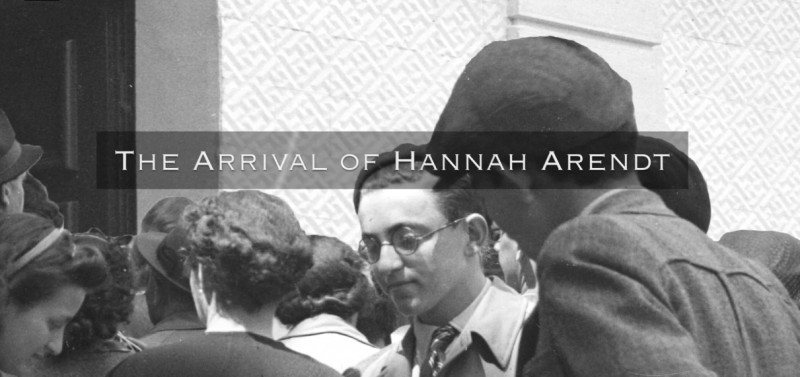
The Arrival of Hannah Arendt
This film describes the arrival of Hannah Arendt - a Jewish, German-American political theorist and publicist - in New York and her reflections on flight and helping people start over.
12. Oktober 38
An die American Guild for German Cultural Freedom
Zwei Kunsthistoriker, Lothar Freund, und Lukas Lehman haben sich an Sie um Zuwendung und an mich für Befürwortung gewandt.
Lothar Freund arbeitet auf dem Gebiet der deutschen Kunst in der Reformationszeit. Er ist ein junger Mensch, der trotz Armut und aller Schwierigkeiten, gründliche und interessante Arbeit macht. Man sollte ihm unbedingt Gelegenheit geben, seine Arbeit durchzuführen, deren Wert mir überdies von guten Kunsthistorikern bestätigt wurde.
Ich möchte auch Lehman befürworten. Hat ein Kind und ist sehr arm. Er arbeitet über deutsche Kunst im Mittelalter (Abhängigk. von der sozialen Struktur u.s.w.)
Ob man den Kunsthistorikern, besonders den unbekannteren, nicht noch eine andre Möglichkeit geben könnte als bloss die geldliche. Bei aller Verschiedenheit in den Auffassungen arbeiten die emigrierten Kunsthistoriker in einer gemeinsamen Richtung, die das Gegenteil von dem ist was jetzt in Deutschland gelehrt wird. Kann man ihnen nicht in hohem Maas Anschluss an Fachverlage u.s.w. ermöglichen?
Noch eine Bitte: Man wendet sich immer an mich um solche Befürwortungen direkt an die Autoren zu schicken. Führen Sie doch einheitlich ein, dass man nur direkt an die Akademie Befürwortungen schickt. Sonst gibt es einen Haufen privaten Ärger, was zwar ertragbar ist, aber die langweiligste Korrespondenz erfordert.
Es grüsst Sie herzlich,
Ihre
Anna Seghers
12 October 1938
To the American Guild for German Cultural Freedom
Two art historians, Lothar Freud and Lukas Lehman, have approached you for grants and me for endorsements.
Lothar Freund works in the field of German art in the Reformation period. He is a young person who, despite poverty and all difficulties, is doing thorough and interesting work.
He should definitely be given the opportunity to carry out his work, the value of which, moreover, has been confirmed to me by good art historians.
I would also like to endorse Lehman. He has a child and is very poor. He works on German art in the Middle Ages (dependence on social structure, etc.).
Whether one could not give the art historians, especially the lesser known ones, another possibility than just a monetary one. Despite all the differences in their opinions, the emigrated art historians work in a common direction, which is the opposite of what is now taught in Germany. Is it not possible to connect them to specialist publishers, etc.?
Another request: One always turns to me to send such endorsements directly to the authors. Why don’t you introduce uniformly that one sends endorsements only directly to the academy. Otherwise there will be a lot of private trouble, which is bearable, but requires the most boring correspondences.
Sincere greetings,
Your
Anna Seghers
Anna Seghers (1900-1983), born Netty Reiling in Mainz, was a German writer of Jewish origin. She studied art history, sinology, history and philology in Heidelberg and Cologne. In 1925 she married László Radványi, a Hungarian social scientist. The couple had two children shortly after, Peter born in 1926 and Ruth born in 1928. Between the births of her children, she published the story “Grubetsch” in 1937, for which she received the prestigious Kleist Prize.
Due to Nazi persecution, Seghers fled to France in 1933, where she remained until 1941, after which she fled to Mexico. Seghers had been a member of the German Communist Party since 1929, as well as the League of Proletarian Revolutionary Writers. This, along with her Jewish background, made her a victim of Nazi persecution. While living in exile in France, she wrote “Der Kopflohn”, “Der Weg durch den Februar”, and “Die Rettung”. The letters that are in this correspondence were all written from her address in Paris. In exile she also wrote “The Seventh Cross”, which she published in 1942, making her famous worldwide. After the war, she published “The Trip of the Dead Girls”, which deals with the murder of her mother in the Piaski concentration camp.
In her letters to Hubertus Prinz zu Löwenstein, the founder of the American Guild for German Cultural Freedom, Anna Seghers advocates for herself and others to receive help for their artistic work. The American Guild for German Cultural Freedom was an organization that helped German artists, writers, and intellectuals in exile whose opportunities to work were impaired by the fascist government in Germany. The goal of the organization was to keep German culture alive outside of Germany, as it could not survive and thrive within German borders. The American Guild for German Cultural Freedom helped these people by providing financial support. The refugee experience of the German exiles was different for each individual. One of the main difficulties in fleeing is adjusting to a completely new place and finding a support system. The American Guild for German Cultural Freedom tried to help the German exiles with this adjustment so that they could also focus on their work at the same time.
Letter from Anna Seghers to Prince Löwenstein, September 1938 © Deutsches Exilarchiv 1933–1945 der Deutschen Nationalbibliothek – German Exile Archive 1933-1945 from the German National Library.